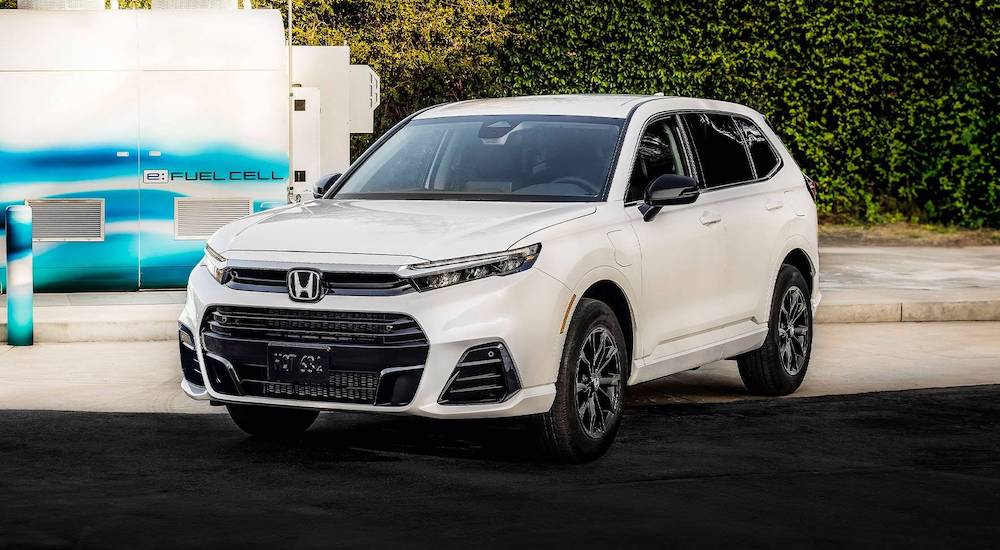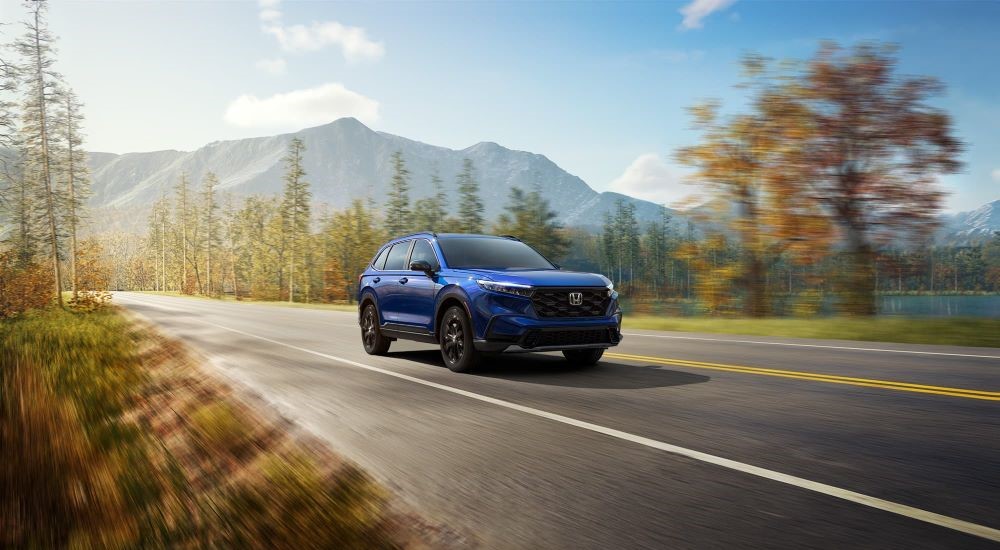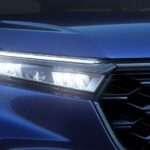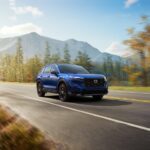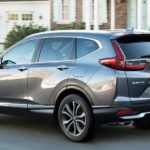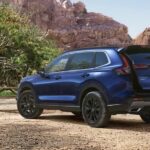Before the end of this year, there will be a new kind of Honda CR-V for sale—at least on the West Coast. Honda is getting set to debut the 2025 CR-V e:FCEV, a technology-merging, boundary-breaking take on their longtime compact crossover. The “FCEV” stands for “fuel cell electric vehicle,” a technology that is gaining ground as part of the ongoing drive toward zero emissions.
This isn’t the first time Honda has offered an FCEV. The Honda FCX Clarity was sold from 2008 to 2014 and again from 2016 to 2021, providing Japan, Europe, and the US with a new environmentally-friendly way to drive. But while the FCX Clarity was the definition of a niche vehicle (according to some estimates, less than fifty such vehicles were leased in the initial run), Honda seems to be positioning the CR-V e:FCEV for something bigger.
For starters, it’s based on the CR-V, which has been part of the Honda lineup for nearly thirty years and sold more than 360,000 units in 2023. Adding that type of name recognition to a new vehicle design shows that Honda means business. Furthermore, it’s unlike anything that even FCEV enthusiasts have ever witnessed. What’s so special about the 2025 Honda CR-V e:FCEV? Here’s a look at what it does and what it could mean for both Honda and the future of fuel cell tech…
How Fuel-Cell Electric Vehicles Work
First, it’s important to understand the basic workings of FCEV technology. These vehicles have a propulsion design like that of battery electric vehicles (BEVs) but use hydrogen as an energy source. A tank is filled with pure compressed hydrogen gas, which feeds into a fuel cell stack. When hydrogen enters a negative electrode, it triggers a reaction that separates the electrons and protons. The electrons are collected and used to power the circuitry.
Manufacturers find fuel cell technology promising for a few reasons. For starters, it produces no chemical emissions; the only byproduct is water vapor. The tank takes a few minutes to fill up, just like a gas tank, and you get the excellent torque and power that electric vehicles are known for. Finally, as hydrogen is the most common element in the known universe, there’s plenty available. (The main challenge is collecting and compressing it.)
How the CR-V e:FCEV Differs From Other FCEVs
Unlike past fuel cell vehicles, where hydrogen was the only fuel, the Honda CR-V e:FCEV will have two power sources. In addition to the hydrogen fuel cell stack, it also has an electric battery that you can plug in for Level II charging. The setup is kind of like a plug-in hybrid (PHEV) where you have an internal combustion engine and electric motor. Here, though, the gasoline has been swapped for hydrogen.
This is a potential game-changer when it comes to FCEV technology. One of the big reasons FCEVs have been slow to catch on is that, even now, there aren’t a lot of consumer-level hydrogen stations beyond certain areas. A secondary plug-in battery gives people more options. According to Honda, the 2025 CR-V e:FCEV will have 270 miles of FCEV range plus another 29 miles of plug-in range. That means drivers can use the electrical battery around town and save the fuel cell for longer journeys, or they can preserve the plug-in power if they know there’s a long stretch between filling stations.
How the CR-V e:FCEV Fits Into the Honda Lineup
The 2025 CR-V e:FCEV comes at a time of rapid shifting for Honda’s alternative fuel vehicles. At the end of 2023, the only models available were the Accord Hybrid and the CR-V Hybrid. The venerable Honda Insight—their original plug-in hybrid—had been discontinued in 2022, one year after the Clarity PHEV and FCEV. Overseas, the supermini Honda “e” BEV had also been given the boot. In all three cases, underperforming sales were cited as the primary reason.
But in sending these vehicles to the trash bin, Honda has made room for a new generation of eco-friendly machines. The Honda Insight will be replaced by the return of the Civic Hybrid, which had been discontinued in 2014; the new version is set to debut for the 2025 model year. Honda is also introducing the Honda Prologue—an all-electric SUV—sometime in 2024.
The CR-V e:FCEV means all three major alternative fuel technologies—hybrid, battery-powered, and fuel cell—will be represented in Honda’s lineup. It also means there are a whopping three versions of the CR-V with the original gas-powered turbo SUV still available. So whether you prefer the convenience and low upfront cost of an internal combustion engine, the fuel efficiency of a plug-in hybrid, or the zero emissions of battery and fuel-cell tech, the CR-V is your SUV.
Why Is the CR-V e:FCEV Only Available in California?
Like its Clarity predecessor, US customers will only be able to lease (not buy) the Honda CR-V e:FCEV in Southern California; everyone else is out of luck, at least for now. According to Honda, the reason is that no other state has a large enough network of retail hydrogen fueling stations to support an FCEV vehicle. To be more specific, as of 2023, there are 59 such stations in the US, and just about all of them are in California; the majority are around Los Angeles and San Francisco, with others scattered in places like San Diego, Sacramento, and Santa Barbara.
There is likely another reason that Honda doesn’t mention. Since 1998, California has required a certain percentage of sales for every automaker doing business there to be hybrid or zero-emission vehicles. That percentage continues to rise, and per the Advance Clean Cars II Act of 2022, all new vehicles must be zero-emissions by 2035. Because of this, many automakers release US vehicles for the California market only. Honda did this with their original all-electric EV Plus from 1997 to 1999 and again with the Honda FCX Clarity. (The Honda Fit EV produced from 2013 to 2015 was also widely speculated to be a “compliance vehicle.”)
However, with other states adopting similar regulations and growing consumer interest in alternative fuel vehicles, the equation may change down the road. At the last report, efforts were underway to build roughly fifty new hydrogen filling stations in the US. While most will be in California, there are plans for several Northeastern hydrogen stations as well as one in Hawaii. In this sense, the Honda CR-V e:FCEV could be seen as a “test balloon” where success could drive future demand in other parts of the country.
A New Kind of Powering Vehicles
With a stated goal of reaching 100% BEV and FCEV sales by 2040, the Honda CR-V e:FCEV is another step along this path. Combining the two alternative fuels helps to bridge the gap as the consumer-level FCEV infrastructure catches up with the technology itself.
Furthermore, Honda is aiming to use its fuel cell module technology beyond automobiles. In March 2023, it began testing the modules to gauge their effectiveness as emergency backup power for data centers. They claim to be doing research into hydrogen technology for outer space, too. Though this may be a ways off, there is plenty of potential in hydrogen fuel cells with or without a battery-electric pairing, and the Honda CR-V e:FCEV represents another step in realizing these possibilities.
